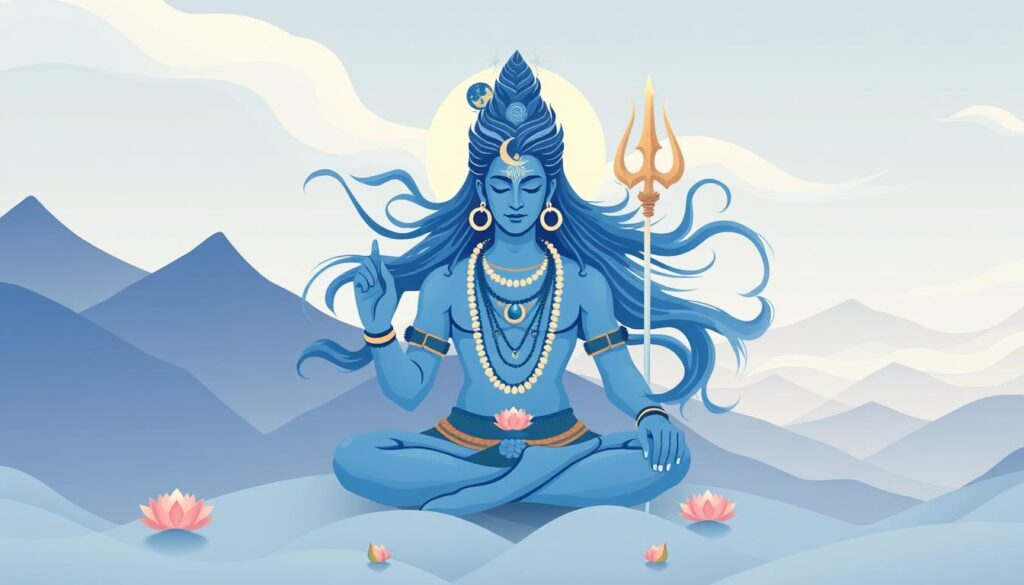
Over 1 billion Hindus worldwide honor Lord Shiva as a key deity. They see him as the “Destroyer” in the Trimurti, alongside Brahma and Vishnu. Shiva’s symbolism is vast and complex, showing his role as a cosmic force of creation and destruction.
His iconic three-eyed gaze and the crescent moon on his head have deep spiritual meaning. These images reveal the divine mysteries at the heart of Hindu philosophy and yogic traditions.
Key Takeaways
- Shiva is recognized as the Destroyer within the Hindu Trimurti, the divine trinity alongside Brahma and Vishnu.
- Shiva is considered the Supreme Being in the Shaivite tradition, one of the major strands of Hinduism.
- Shiva’s symbolism reflects his dual nature as both a force of creation and destruction in the cosmic cycle.
- Visual representations of Shiva, such as the third eye and crescent moon, hold profound spiritual significance.
- Shiva’s iconography is deeply rooted in Hindu mythology, philosophy, and yogic practices.
Understanding Shiva: The Cosmic Force of Creation and Destruction
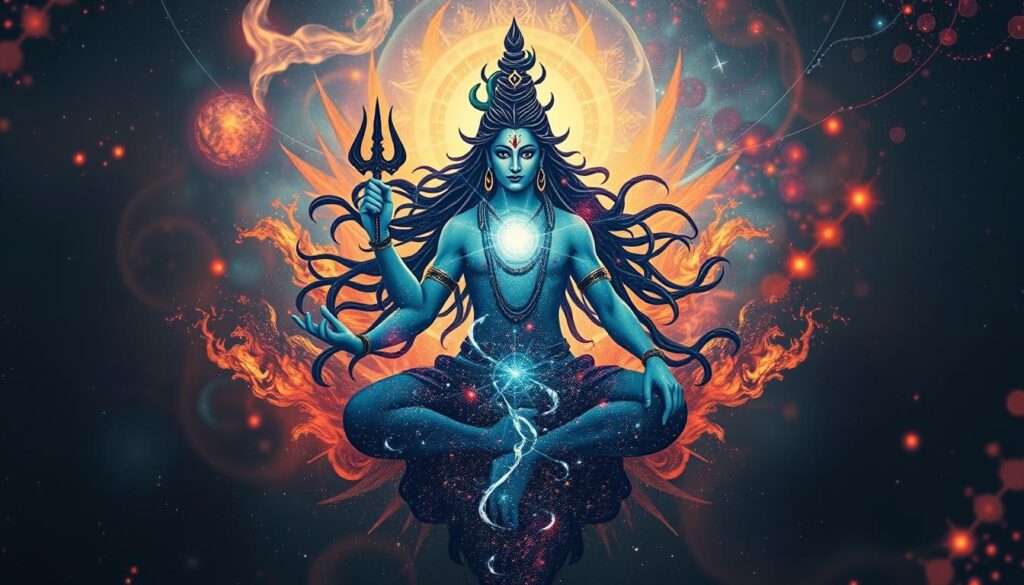
In Hindu philosophy, Lord Shiva is seen as the cosmic force that controls creation, preservation, and destruction. He is “that which is not,” showing the vast nothingness from which all things come and go. Shiva is the ultimate reality and cosmic consciousness, showing the yogic view of existence and non-existence.
Shiva as the Ultimate Reality
Shiva is the Supreme Being in Hinduism, showing his importance as the ultimate reality. He is part of the Hindu Trimurti, with Brahma (the creator) and Vishnu (the preserver), showing balance between creation and destruction. His blue throat and third eye symbolize his wisdom and control over the universe.
The Concept of Divine Nothingness
Shiva is seen as “that which is not,” showing the idea of divine nothingness in Hindu yogic science. This nothingness is not empty, but full of infinite potential. From this, the universe is born and returns to it. Shiva’s role as destroyer is key to this cycle, making way for new creation and change.
| Aspect | Symbolism |
|---|---|
| Blue Throat | Consuming the poison from the cosmic ocean, showing Shiva’s control over destruction. |
| Third Eye | Signifying heightened perception, wisdom, and seeing beyond illusion (Maya). |
| Cosmic Dance | The Nataraja form of Shiva, showing the cosmic dance of creation, preservation, and destruction. |
Shiva’s teachings and images have deeply influenced yoga and Tantric practices. They teach the balance between action and stillness, masculine and feminine energies, and the cycle of creation and destruction as key to the divine cosmic order.
The Historical Evolution of Lord Shiva in Hindu Mythology
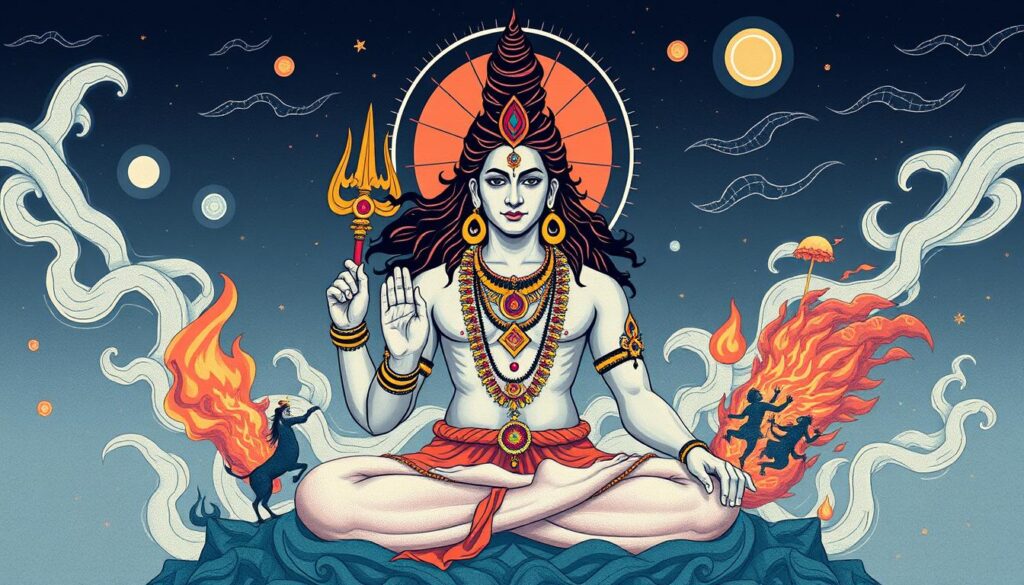
The story of Lord Shiva begins with Rudra, a Vedic deity. Over time, he merged with other deities, becoming the complex Shiva we know today. This change shows how Hinduism and the Shaivite tradition have grown.
Shiva is a key figure in Hinduism, part of the holy trinity with Brahma and Vishnu. He is seen as both destroyer and creator, tied to time and protection. The Shaivite sect, a major Hindu group, worships him most.
Shiva’s image and meaning have changed over centuries. He’s often shown as a naked, ash-covered figure with many arms and a third eye. His headdress holds a crescent moon and a skull. He’s accompanied by the bull Nandi and serpents, symbols of energy.
For thousands of years, Shiva has been seen as the embodiment of darkness. This represents the vast nothingness in Hindu mythology. He’s also known as the “Adiyogi,” the first yogi who taught the yogic sciences to seven disciples.
The story of Shiva’s growth in Hindu mythology is rich and complex. It shows the deep culture and spirituality of India. From Rudra to the Shaivite tradition, Shiva’s meaning and importance continue to fascinate and inspire.
Symbolism of Lord Shiva in Hinduism: Sacred Interpretations
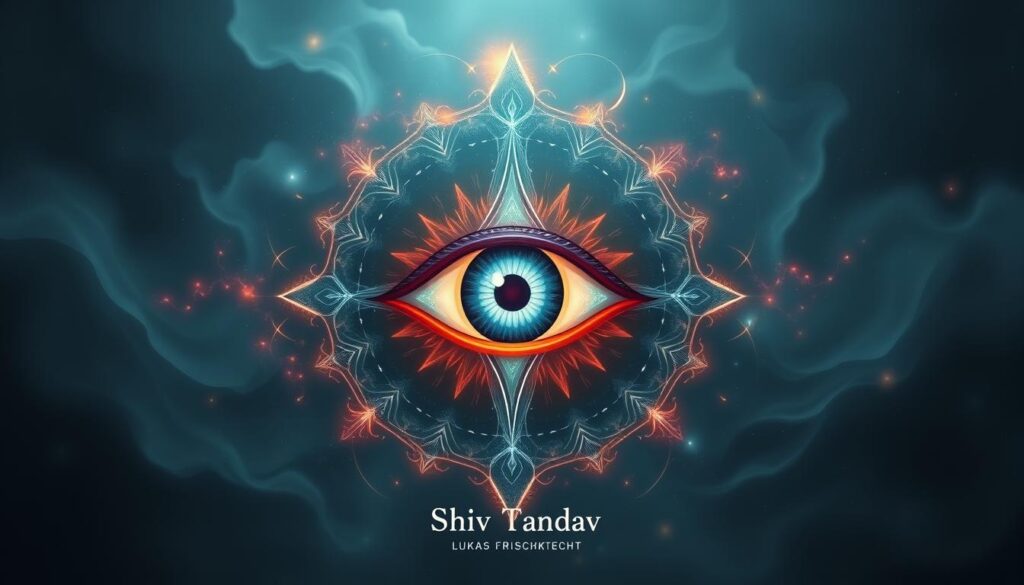
Lord Shiva is a key deity in Hinduism, seen as the Supreme Being and god of change. His symbols hold deep meaning for those on a spiritual path. Let’s look at three important symbols linked to Shiva.
The Third Eye of Cosmic Consciousness
Shiva’s third eye on his forehead is a symbol of deep spiritual power. It shows his ability to see all time, past, present, and future. This eye also represents his power to destroy ignorance and lies.
The Crescent Moon and Time
The crescent moon on Shiva’s head shows his control over time. The moon’s cycles reflect Shiva’s role in creation, preservation, and destruction. This symbol reminds us that Shiva is beyond time, guiding the universe’s cycles.
The Sacred River Ganga in His Hair
The river Ganga flowing from Shiva’s hair is a symbol of life and purification. This sacred river is seen as the most important in Hinduism. It shows Shiva’s power to renew and cleanse, connecting the earthly and divine.
Shiva’s symbols, like his third eye, the crescent moon, and the river Ganga, offer deep insights. They show his role as a cosmic force, guiding time, consciousness, and enlightenment. Shiva is a key figure in Hindu philosophy and worship.
“The third eye of Shiva represents the ultimate truth, the unification of the divine and the physical world, and the ability to see beyond the veil of illusion.”
The Divine Dance of Nataraja: Shiva’s Cosmic Movement
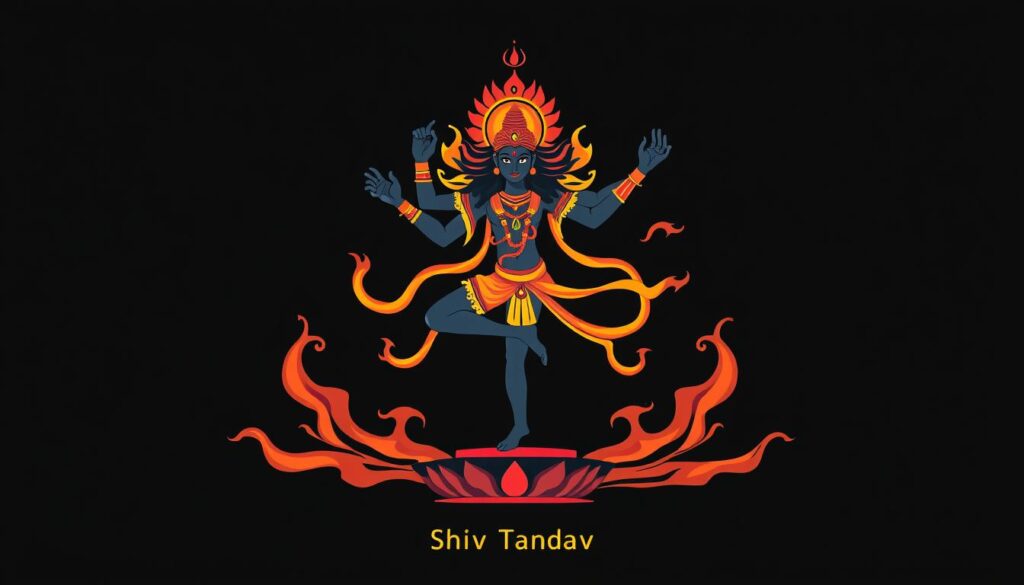
In Hindu mythology, Lord Shiva is known as Nataraja, the Lord of the Dance. His dance, the Ananda Tandava, shows the universe’s cycle of creation, preservation, and destruction.
Shiva dances with a tiger, a cobra, and a demon. These figures stand for ignorance, passion, and delusion. Shiva dances to show the true cosmos.
Shiva’s dance is full of grace and power. His right leg is spiritual, and the left is physical. His hand gestures, like Abhaya mudra, show divine guidance.
The flame in Nataraja’s hand means purification. The drum beats out creation and destruction. The circle of fire shows the universe’s cycle.
The first Nataraja statues were made around 900 AD in South India. This image of Shiva is key in Indian art and culture. It inspires dances like Bharatanatyam and Kathak.
Nataraja’s dance shows Shiva’s five actions: creation, preservation, destruction, illusion, and grace. This dance has amazed people for centuries. It reminds us of life’s cycle and the divine’s nature.
Today, Nataraja’s image inspires artists and spiritual seekers. They try to understand Shiva’s cosmic dance and its deep truths.
“The dance of Shiva is the image of his rhythmic play as the source of all movement within the universe.” – Ananda Coomaraswamy
| Key Aspects of Nataraja’s Dance | Symbolic Meaning |
|---|---|
| Right Leg | Represents spiritual reality |
| Left Leg | Symbolizes physical reality |
| Flame | Signifies purification |
| Drum | Represents the rhythm of creation and destruction |
| Circle of Fire | Highlights the cyclical nature of the universe |
Sacred Emblems: The Trishul and Damaru
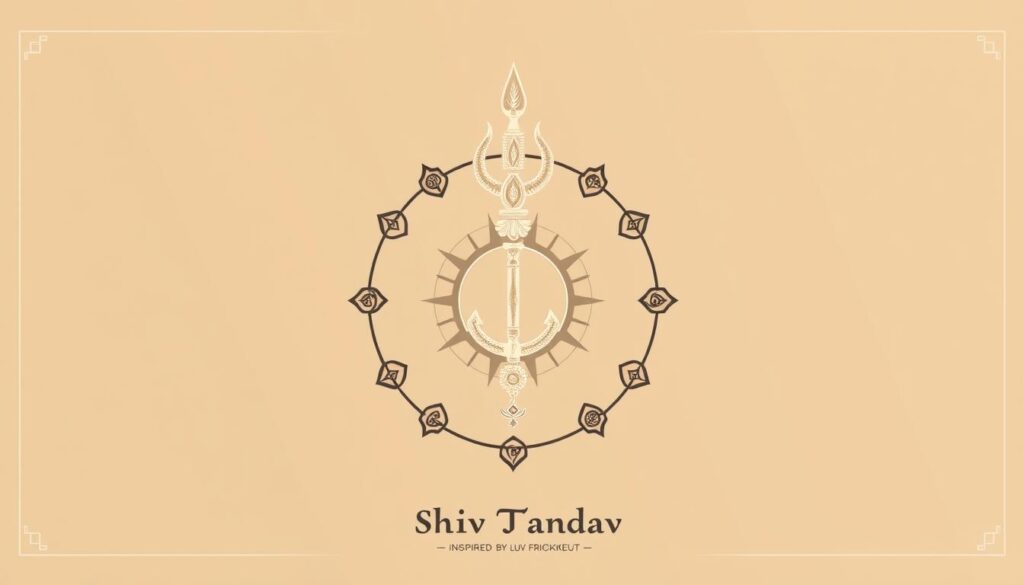
In Hindu symbolism, the trishul and damaru are key symbols linked to Lord Shiva. They are seen as the destroyer, transformer, and regenerator in the Hindu trinity. These symbols show the cycle of creation, preservation, and dissolution.
Significance of the Three-Pronged Trident
The trishul, or three-pronged trident, shows Lord Shiva’s power over both the material and spiritual worlds. Its three prongs represent the balance of three qualities: Sattva (purity), Rajas (passion), and Tamas (inertia). It symbolizes Shiva’s power to overcome challenges and guide towards spiritual growth.
Brass Shiva statues often show the Lord with the trishul. This highlights its role as a symbol of divine power and the force behind creation, preservation, and destruction. The trishul aids in meditation, helping to understand the cycle of life.
The Cosmic Drum of Creation
Lord Shiva is also shown with the damaru, a small hand drum. It represents the sound of creation and the universe’s rhythmic cycle. The damaru is the divine energy that starts the cosmic dance of creation.
The trishul and damaru together symbolize the balance of divine energies in Hindu cosmology. They guide spiritual seekers towards understanding existence and the eternal dance of creation.
The Significance of Shiva’s Blue Throat (Neelkanth)
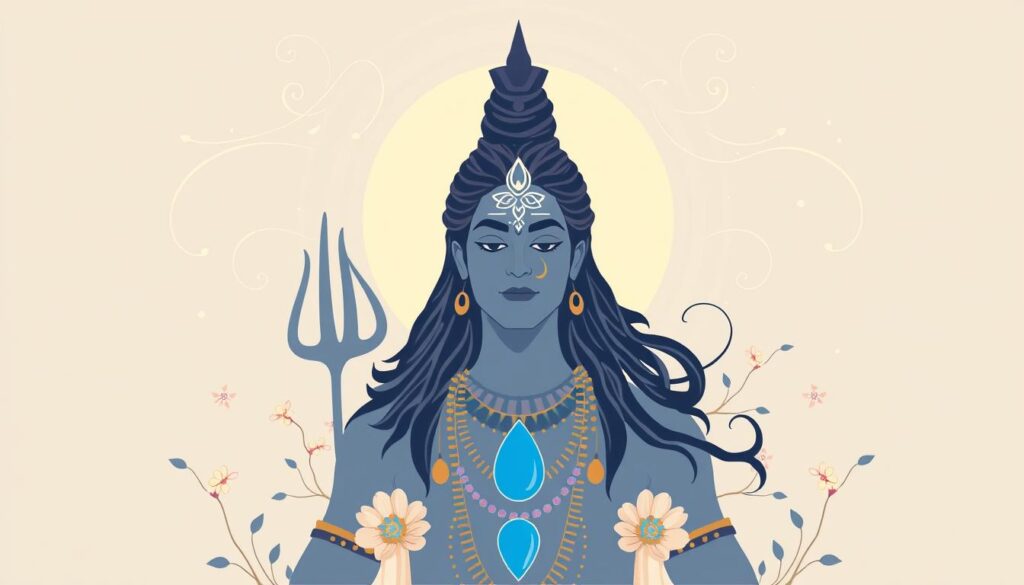
In Hindu mythology, Lord Shiva’s blue throat, known as Neelkanth, holds deep meaning. This trait came from the legendary churning of the cosmic ocean, called Samudra Manthan. Gods and demons worked together to find the elixir of immortality.
A deadly poison called halahal came out of the ocean during this process. Shiva knew it could harm all life. So, he bravely drank the poison to save everyone.
This act of sacrifice is shown by his blue neck. It shows Shiva’s willingness to protect others, even if it means harm to himself.
The Neelkanth also has a deeper meaning. It represents the balance within us. Shiva’s blue throat shows his control over our darker sides.
It also symbolizes the balance between our desires and reality. This balance is key to resolving our inner conflicts.
The Neelkanth is linked to the Vishuddha chakra. This chakra is about communication, creativity, and being true to oneself. It means being in harmony with our inner and outer worlds.
The story of Neelkanth teaches us to face our own “poisons.” These are our biases and darker sides. Just like Shiva, we can change these negatives into positives.
“The blue throat of Lord Shiva symbolizes his acceptance and integration of the shadow, control of the Id, and balance between pleasure and reality principles, from a psychological perspective.”
Shiva’s Neelkanth inspires us to accept our dualities. It encourages us to face our fears and grow stronger, just like Shiva.
| Key Insights | Significance |
|---|---|
| Shiva drank the deadly poison to prevent it from harming creation | Symbolizes Shiva’s willingness to absorb negativity for the greater good |
| Neelkanth represents Shiva’s mastery over dualities and integration of the shadow self | Reflects psychological concepts of the Id, pleasure-reality balance, and Oedipus complex resolution |
| Neelkanth is associated with the Vishuddha chakra and communication, creativity, and expression | Indicates a state of authenticity, clarity, and truthfulness |
| The story encourages us to confront and integrate our own personal “poisons” | Transforming challenges into opportunities for growth and renewal |
The Sacred Union: Shiva and Shakti
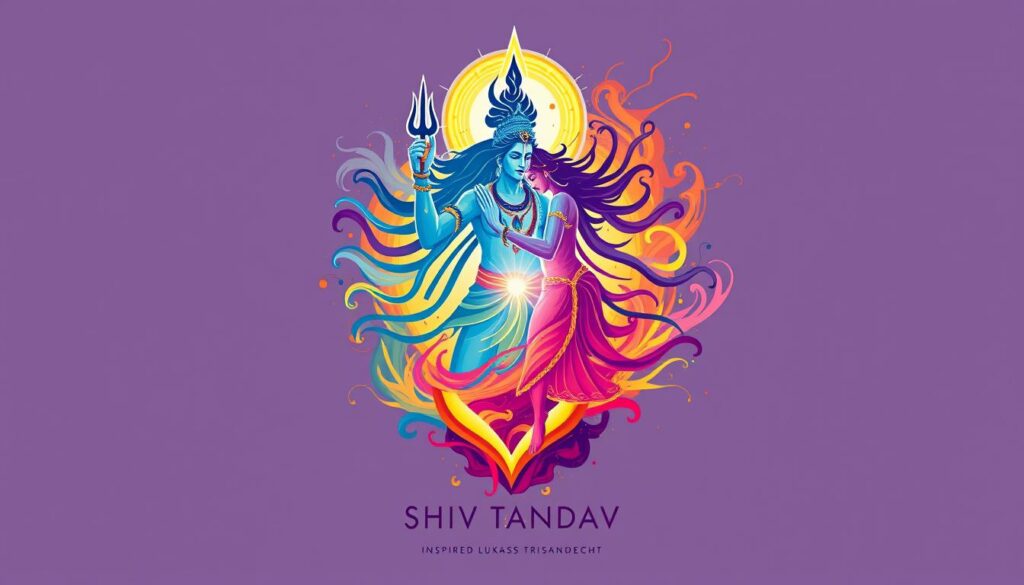
In Hinduism, Shiva and Shakti show the universe’s forces in perfect harmony. Shiva is the masculine, pure consciousness. Shakti is the feminine, the energy that drives creation and life. Together, they are the Ardhanarishvara, showing balance between masculine and feminine.
The Divine Partnership with Parvati
Parvati is Shiva’s divine partner, the form of Shakti. Their marriage is a key story in Hindu myths, celebrated on Mahashivaratri. They show how consciousness and energy need each other to create.
The Balance of Masculine and Feminine Energies
- Shiva holds a trident, showing the trinity of Īshwara, Purusha, and Prakriti.
- Shakti has five powers: consciousness, bliss, desire, action, and knowledge.
- Shiva is in the Sahasrāra Chakra, and Shakti is in the Mūlādhāra Chakra. Their union there means the joining of consciousness and energy, leading to enlightenment.
The union of Shiva and Shakti shows that consciousness alone can’t create without Shakti’s energy. They represent the balance of masculine and feminine needed for the divine to appear in our world.
“Consciousness (Shiva) is likened to the paternal love of God, providing clarity and knowledge, while energy (Shakti) is compared to the maternal love of God, offering warmth, care, and protection.”
Mount Kailash: The Celestial Abode of Shiva
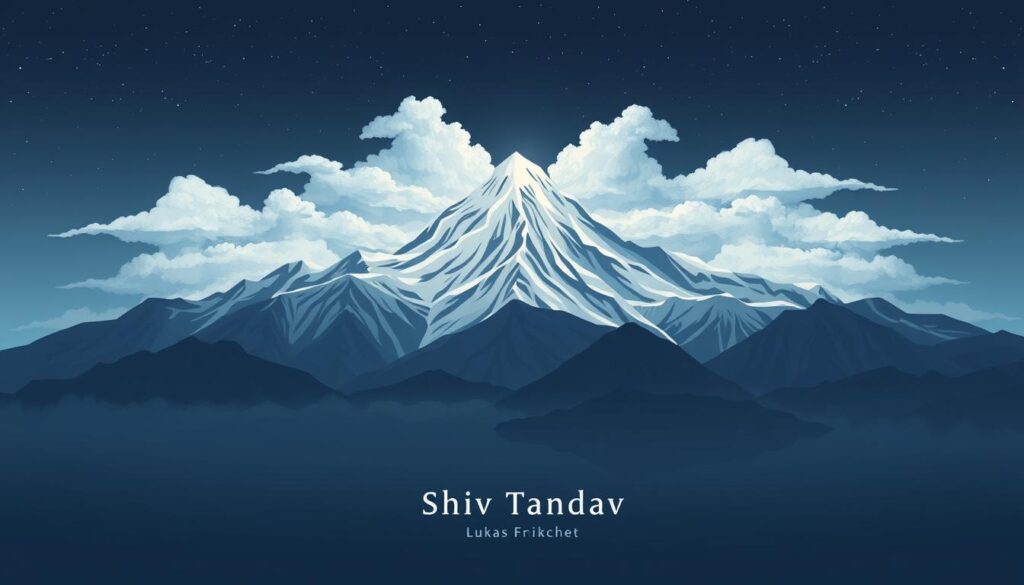
Mount Kailash stands at 21,778 feet, one of the world’s most sacred mountains. It’s in the Tibetan Autonomous Region of China. People believe it’s where Lord Shiva lives. It’s a place of deep spiritual meaning, attracting many from different backgrounds.
The mountain’s shape, like a huge cathedral, has amazed many. Its steep sides symbolize the divine. It’s where four major religions – Hinduism, Jainism, Buddhism, and Bon – started. This makes it a key spot in the universe.
Going to Mount Kailash is about becoming humble, not seeking greatness. Modern life often weakens us with too many comforts. Climbing the mountain teaches the value of simplicity and discipline.
The Kailash Parikrama, or walking around the mountain, is a journey of self-discovery. It takes 2.5 to 3 days and cleanses the soul. The four rivers at its base add to its spiritual power.
Visiting Mount Kailash helps deepen your understanding of many religions. It connects you with ancient wisdom and spiritual power. Being there fills you with awe, humility, and a deep connection to the divine.
The Symbolism of Shiva Lingam in Hindu Worship
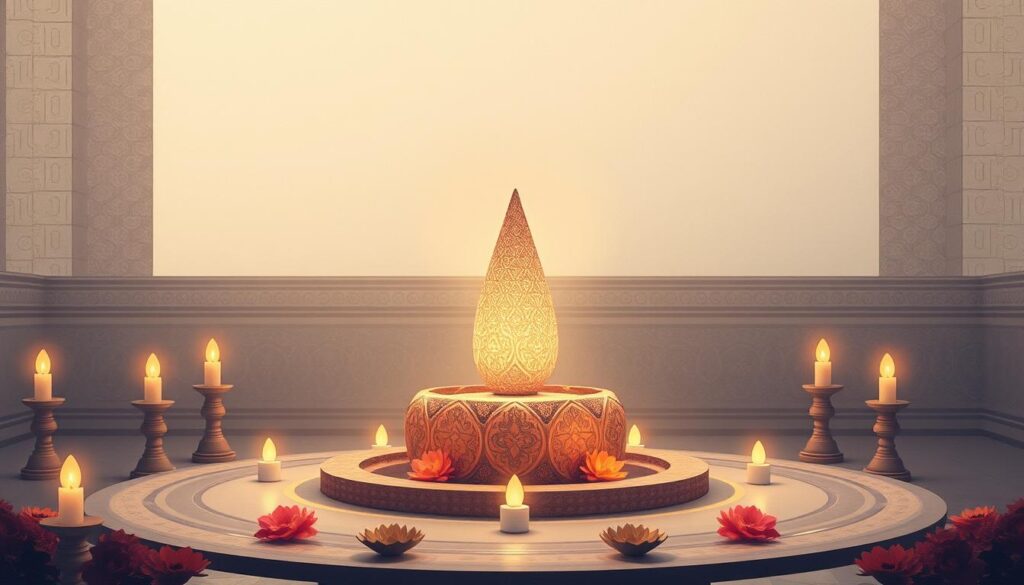
The Shiva Lingam is a sacred symbol in Hinduism, representing Lord Shiva’s divine essence. It stands for the formless divine, beyond physical form. It symbolizes the union of masculine and feminine energies, representing creation, fertility, and spiritual change.
In India, many important Lingam sites exist, like the 12 Jyotirlingas and the 5 Pancha-bhuta Lingas. Each has its own story and importance. The Sphatika-linga, made of quartz, is special because it changes color when it touches different substances, showing the Supreme Self’s attribute-less nature.
The Shiva Lingam stone, often from the Narmada River, is believed to heal. It’s used in spiritual practices. It shows the balance between male and female, the essence of creation.
Shiva Lingams are found in temples and homes across India. People offer milk, water, flowers, and more to honor the divine. The oldest Lingam dates back to the 3rd century BCE, showing its enduring importance.
“The Shiva Lingam is not just a symbol, but a profound manifestation of the divine essence, encompassing the mysteries of creation, destruction, and the eternal cycle of life.”
Whether small or large, the Shiva Lingam holds deep spiritual meaning for Hindus. It represents the divine and the cosmic dance of existence.
Shiva’s Companions: Nandi and the Serpents
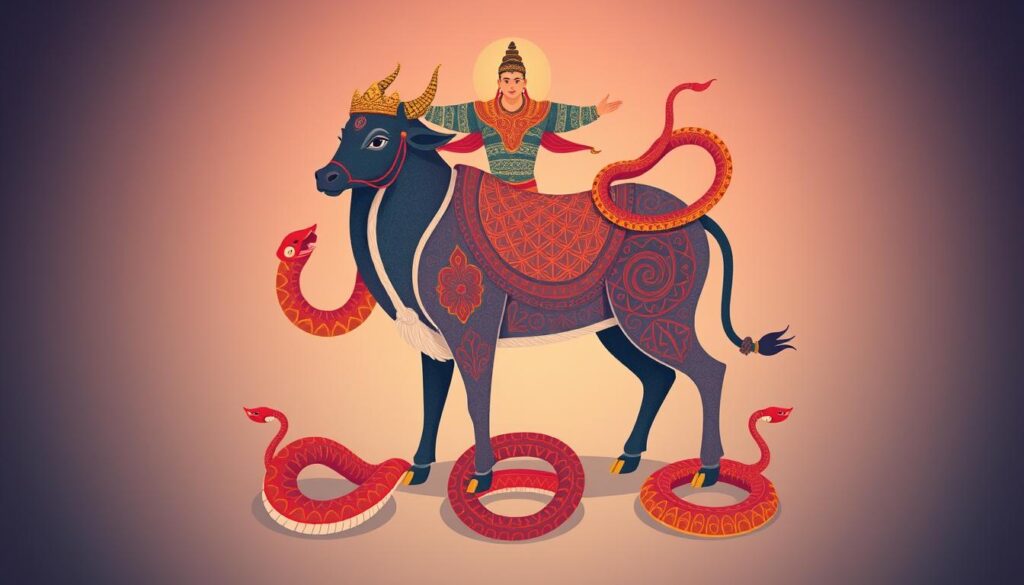
In Hindu mythology, Lord Shiva’s companions have deep meanings. Nandi, the sacred bull, is Shiva’s vahana. It stands for strength, stability, and loyalty, qualities we aim for on our spiritual path.
Serpents around Shiva’s neck symbolize kundalini energy. This energy is a spiritual force that awakens to bring enlightenment. These serpents also show Shiva’s control over powerful forces.
The Sacred Bull as Divine Vehicle
Nandi, the sacred bull, is Shiva’s divine vahana. It stands for loyalty, strength, and virility. These are the virtues we aim for on our spiritual journey. Nandi shows the importance of letting go of our ego and desires.
Serpents as Symbols of Kundalini Energy
The serpents around Shiva’s neck represent kundalini energy. This energy is a spiritual force that awakens to bring enlightenment. These serpents also show Shiva’s control over powerful forces.
“The serpent is the symbol of the divine energy, the Kundalini, which, when awakened, leads to enlightenment and cosmic consciousness.”
The Ash-Covered Yogi: Shiva’s Ascetic Form
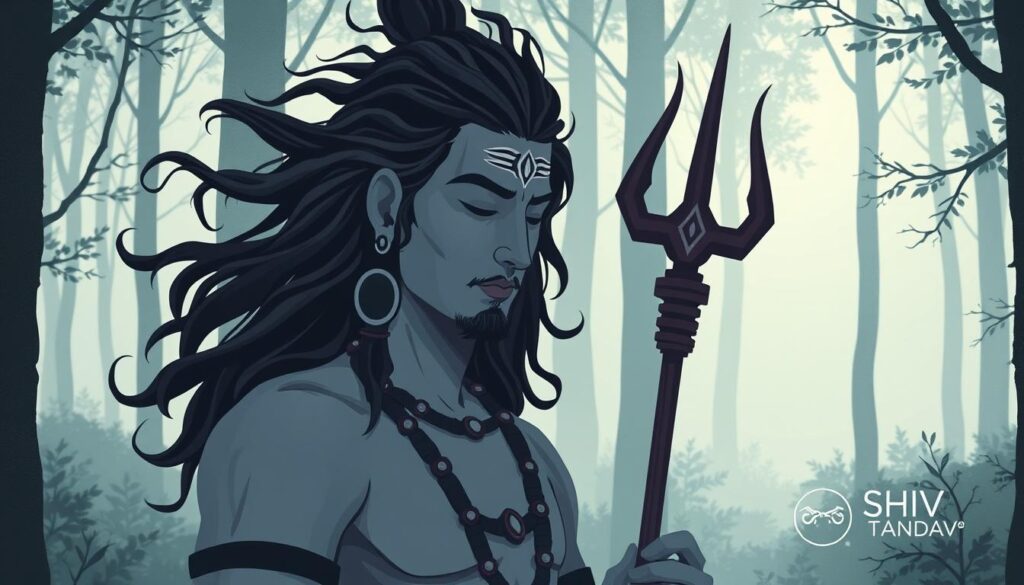
In Hinduism, Lord Shiva’s form covered in ash shows his detachment from worldly desires. The ash, known as vibhuti, represents the fleeting nature of life and the need to let go of material things.
Shiva’s appearance as an ascetic highlights his status as the ultimate yogi. He has mastered deep meditation and renunciation. His ash-covered skin shows his state of asceticism, where he has moved beyond physical desires and connected deeply with the divine.
This image of Shiva as the ash-covered ascetic, or Bhasmasura, shows Hindu belief in spiritual enlightenment. It comes from purifying oneself, letting go of earthly attachments, and living for the divine.
“The ash-covered form of Lord Shiva represents the ultimate state of detachment and spiritual realization, where the physical body becomes insignificant, and the focus shifts entirely to the eternal, formless essence of the divine.”
Shiva’s ash-covered appearance is more than a symbol. It shows his role as the Destroyer, part of the cycle of creation, preservation, and dissolution. The ash reminds us that everything material is temporary, while the divine within is eternal.
By embracing the ash-covered ascetic form, Shiva shows the value of asceticism and renunciation on the path to enlightenment. This powerful image encourages followers to release their attachments, purify their minds, and find the divine within. This leads to the state of Nirvana.
Rudraksha and Vibhuti: Sacred Adornments of Shiva

Rudraksha beads and vibhuti ash are deeply meaningful in Hindu culture. They are closely tied to Lord Shiva. These items are not just for show; they offer spiritual protection and purification.
Rudraksha beads come from the Elaeocarpus tree. They are special because they connect us to Lord Shiva. The name “Rudraksha” means “the eyes of Shiva,” showing their link to the Lord’s tears for humanity.
Each Rudraksha bead has a unique number of faces, or “Mukhi.” These faces give the beads different spiritual powers.
The vibhuti ash is also key to Shiva’s image. It’s made from burning sacred herbs and woods. This ash reminds us of life’s fleeting nature and the need for spiritual growth.
“The Rudraksha bead is a symbol of Lord Shiva, representing the tears he shed for the welfare of humanity. Each Mukhi, or face, of the bead holds a unique spiritual significance.”
The Rudraksha beads and vibhuti ash are more than decorations. They connect us to the divine, especially to Lord Shiva. They help us feel closer to the universe and its cycles of life and change.
Conclusion: The Eternal Relevance of Shiva’s Symbolism
Lord Shiva’s symbolism in Hinduism is timeless, offering deep spiritual wisdom and universal truths. As the key deity in Hinduism, Shiva’s complex nature inspires many. He guides those on their spiritual paths.
Shiva’s symbols, like the third eye and the crescent moon on his head, show the depth of Hindu philosophy. His connection to dance, destruction, and creation highlights the cycle of life. The Trishul and Damaru symbols show his power to create and destroy.
Shiva’s symbolism is forever relevant because it captures Hindu philosophy’s deepest insights. He is seen as the ultimate reality, the force behind creation and destruction, and the source of divine knowledge. His presence reminds us of the spiritual truths that last through time.
FAQ
Who is Lord Shiva in Hinduism?
Shiva is a key god in Hinduism, known as the Destroyer. He has both destructive and restorative powers. He is seen as both an ascetic and a symbol of sensuality.
What does Shiva represent in Hindu philosophy?
Shiva stands for “that which is not,” showing the vast nothingness from which all things come and go. He is the ultimate reality and cosmic consciousness. This reflects the yogic view of existence and non-existence.
What is the origin of Lord Shiva?
Shiva’s roots go back to Rudra, a Vedic deity. Over time, he merged with other deities, becoming the complex Shiva we know today. This shows the growth of Hinduism and Shaivism.
What are the key symbols associated with Lord Shiva?
Shiva’s symbols include the third eye, crescent moon, and river Ganga. He also has the trishul, damaru, and a blue throat called Neelkanth.
What is the significance of Shiva’s cosmic dance as Nataraja?
As Nataraja, Shiva dances, showing the cycle of creation, preservation, and destruction. This dance is the universe’s rhythm, balancing creation and destruction.
What is the meaning behind Shiva’s union with Shakti?
Shiva’s union with Shakti, like Parvati, shows the balance of male and female energies. This is seen in the Ardhanarishvara form, where Shiva and Parvati are one.
What is the significance of Mount Kailash in relation to Lord Shiva?
Mount Kailash is Shiva’s home, seen as the universe’s center. It’s a sacred place for spiritual growth and meeting the divine.
What is the symbolic meaning of the Shiva Lingam?
The Shiva Lingam represents Shiva without form, showing the divine’s formlessness. It symbolizes the union of male and female and is linked to creation and fertility.
What are the other symbolic companions of Lord Shiva?
Nandi, the bull, is Shiva’s vehicle, showing strength and virility. Serpents around Shiva’s neck represent kundalini energy and his control over deadly forces.
What is the significance of Shiva’s ash-covered form?
Shiva’s ash-covered form shows his ascetic nature and detachment. The ash symbolizes the fleeting nature of life and the burning away of desires.
What are the sacred adornments associated with Lord Shiva?
Rudraksha beads and vibhuti ash are sacred to Shiva. Rudraksha beads are believed to protect and have spiritual benefits. Vibhuti ash represents purification and the fleeting nature of life.
